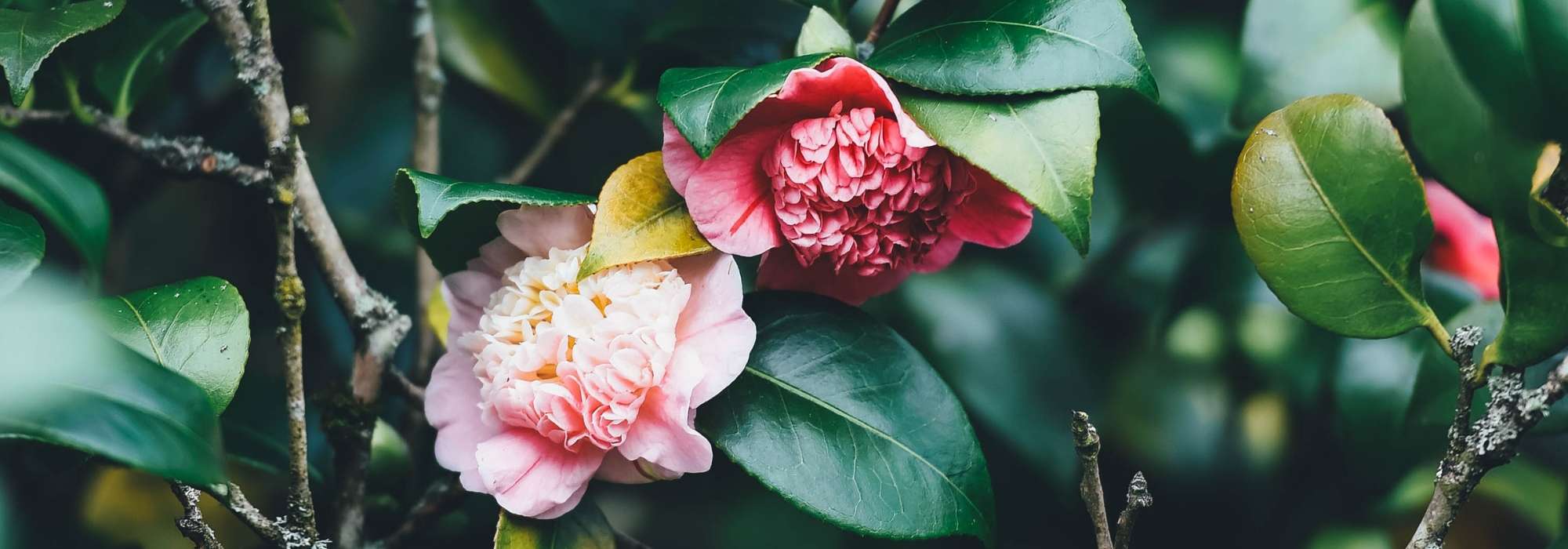
Camellias: planting, pruning and care
Contents
Camellias, in a nutshell
- Camellias are evergreen bushes that flower in autumn, winter or spring, depending on the variety.
- They thrive in light, acidic soils rich in humus.
- Camellias prefer shade or partial shade and grow easily at the edge of woodland.
- There are many varieties and cultivars that differ in their flowering period as well as in the shape and colour of the flowers.
- Some can be used in an informal hedge, but they are best grown as solitary specimens or in pots.
A word from our expert
Camellias, with their vibrant flowering and evergreen foliage, are essential to enliven gardens during the most ternate periods of year. These bushy bushes stand out for their ability to provide bright colours when most plants are dormant, thanks to their varied flowering periods. Here is an in-depth look at these remarkable plants:
Camellias reveal themselves in all their splendour, mainly in two seasons: autumn and spring. Camellia sasanqua announces arrival of autumn with its delicate flowers, while Camellia japonica and Camellia x williamsii take over in late winter, extending the flowering into early spring. This succession of flowering, from October to early May, ensures a colourful and invigorating presence in garden at a time when few other flowers emerge.
Native to dense forests, Camellias show a strong preference for shaded or partially shaded environments. They thrive in soil rich in humus, slightly acidic, which best reproduces their natural forest habitat. These soil conditions promote healthy growth and abundant flowering, providing Camellias with the nutrients and ideal pH for their development.
Limestone is the sworn enemy of Camellias, as it causes iron deficiency, harmful to their health. Symptoms of chlorosis (yellowing of leaves) appear when these bushes are planted in calcareous soil, jeopardising their growth and flowering. Thus, success in growing Camellias depends on choosing a suitable site and preparing an appropriate substrate, free from lime and rich in organic matter.
In summary, Camellias enrich garden with their winter and spring flowering, bringing colour and life during darkest months. Their need for shade or partial shade, together with well-drained soil rich in humus and acidic, is essential for their flourishing. By avoiding calcareous soils, gardeners can enjoy the beauty of Camellias without having to fear the problems of chlorosis.
Description and botany
Botanical data
- Latin name Camellia sasanqua, Camellia japonica and Camellia x williamsii
- Family Theaceae
- Common name Camellia
- Flowering from October to May (depending on species and varieties)
- Height 1 to 3 m
- Exposure shade, partial shade
- Soil type acidic and light, rich in humus
- Hardiness -10 °C
The Camellias, Camellia in Latin, belong to family Theaceae (or Theaceae). They are bushy bushes with evergreen, alternate and leathery foliage.
Genus Camellia comprises nearly a hundred species, whose most famous representative, Camellia sinensis, is a bush cultivated for its leaves and which gave us a beverage consumed worldwide: tea. Camellias occur wild in temperate forests across Asia.
Three main species, among the hundred recorded, are grown for ornamental purposes in gardens:
- Camellia japonica,
- Camellia sasanqua,
- Camellia x williamsii.
All have evergreen, glossy foliage. Their main quality is ability to flower in the off-season, that is in autumn for C. sasanqua, in mid-winter for C. japonica and in early spring for C. x williamsii.
Camellias offer great diversity, also seen in the shape of their flowers. Flowers can be single, semi-double, double (anemone-form, peony-form, rosette or imbricate), with stamens more or less visible. Some are scented (‘High Fragrance’, ‘Yume’), others not scented at all.

Different types of camellia flowers: single-flowered (Camellia sasanqua ‘Gay Border’) / semi-double-flowered (Camellia japonica ‘Adolphe Audusson’) / anemone-form (Camellia japonica ‘Bob’s Tinsie’ – ©Stervinou) / peony-form (Camellia ‘Sweet Jane’ – ©Stervinou) / imbricate (Camellia ‘Nuccio’s Pearl’)
Camellia japonica
Probably most famous of camellias (the one belonging to Alexandre Dumas’ lady…) with some 35,000 cultivars worldwide (according to International Camellia Register). Hard to choose among all these magnificent camellias, but certainly impossible not to find one you will like. Plant this slow-growing, bushy bush in shade or partial shade, preferably dappled shade (near a wall for example) rather than deep shade under tree canopy. Its slow growth gives it a compact habit, but over time it can become a bush nearly 3 metres across. Flowers are single, semi-double or double and unscented while its evergreen, alternate foliage is dark green.
Beware! It is least hardy of the group. Flower buds freeze from about -4 °C and its branches die at -10 °C. It will regrow from stump afterwards, but will take several years to flower again.

Camellia japonica ‘Sweet Olive’ / ‘Valtevareda’ / ‘Volunteer’ (photos ©Stervinou)
Camellia sasanqua
Pronounce it “sa-san-kwah”. Often called autumn camellia, as it flowers from October to December. It grows very well along Atlantic coast and in Normandy, but elsewhere it will need a sheltered situation. Indeed, its flowering can suffer from an early frost and it dislikes prolonged cold spells. Its hardiness is around -10 °C. Plant it in full sun north of Loire, but in partial shade elsewhere. Its single, semi-double or double flowers are scented and then evoke jasmine tea. A warm summer will favour a profusion of flowers in autumn. Leaves are oblong, 5 to 8 cm long, evergreen and dark green above, paler beneath. Its thick, leathery foliage allows it to cope well with summer droughts. Its slow growth and compact habit, rarely exceeding 1.5 metres, make it ideal for container planting. Otherwise, with its irregular silhouette and flexible branches giving a very Japanese look, it will be perfect in a bed of ericaceous plants alongside azaleas, Skimmias and Pieris.
Please note: there is a subspecies of C. sasanqua called Camellia sasanqua subsp. hiemalis, sometimes noted Camellia x hiemalis or even Camellia sasanqua var. ‘Hiemalis’ or simply Camellia hiemalis (who said botany was complicated?). This one often flowers for longer than Camellia sasanqua, frequently until January.

Camellia sasanqua ‘Frosted Star’, ‘Fuji no Yuki’, ‘Sekiyo’ and Camellia x hiemalis ‘Bonanza’ (photos ©Stervinou)
Camellia x williamsii (hybrid between C. saluenensis and C. japonica)
This camellia, with glossy green, slightly dentate and evergreen foliage, likes partial shade but still needs a few hours of sun to flower well. Its habit is bushy and its growth moderate. It literally covers itself with single, semi-double or double flowers in spring, larger than those of other camellias, but unscented. Note also that its flowers fall once faded, making this camellia a self-cleaning bush. It is the hardiest among camellias in cool, humid climates. Every year new hybrids appear on market, increasingly hardier, more vigorous and more interesting. Do not be put off by preconceived ideas about camellias and give a small williamsii a try at home!

Camellia x williamsii: ‘Cinnamon Scentsation’, ‘High Fragrance’, ‘Cinnamon Cindy’
Other species, original but more marginal
Many other camellias for ‘collection’ exist, notably: Camellia lutchuensis (which we are pleased to offer at promesse de fleurs), but also C. hongkongensis, C. transnokoensis, C. chrysantha (with yellow flowering)… Each has its own qualities and specificities, but it would be unrealistic to try to describe them all, or even simply to name them. If urge to start collecting genus Camellia tickles you, we can only wish you good luck in your new life as a “Camelliophile” and hope to see you soon at a rare and collector plant fair…
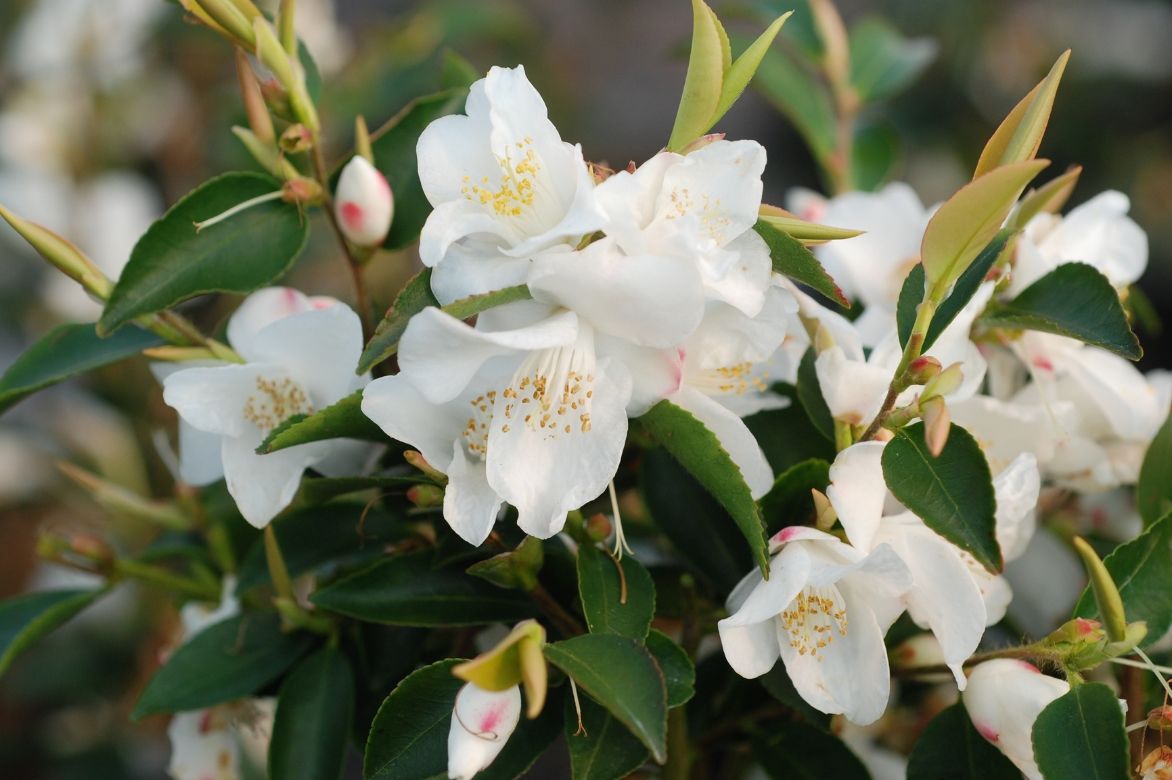
Camellia lutchuensis (photo ©Stervinou)
Read also
4 rustic camellias for a natural gardenSome very popular varieties
As seen, camellias include many species which themselves include numerous cultivars. Here are some of the varieties most appreciated by gardeners and our favourites.
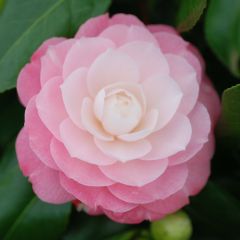
Classic Camellia - Camellia japonica Sweet Olive
- Flowering time April, May
- Height at maturity 1,40 m
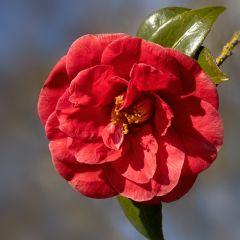
Camellia japonica Adolphe Audusson
- Flowering time March to May
- Height at maturity 1,80 m
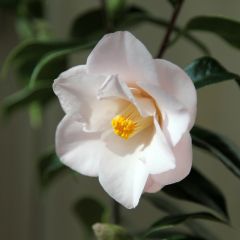
Camellia japonica Hagoromo
- Flowering time March to May
- Height at maturity 2 m
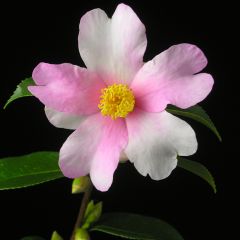
Camellia sasanqua Yume
- Height at maturity 1 m
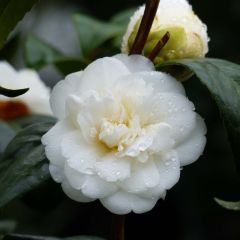
Camellia japonica Nobilissima
- Height at maturity 1,50 m
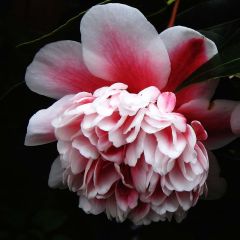
Camellia japonica Volunteer
- Flowering time March to May
- Height at maturity 1,20 m
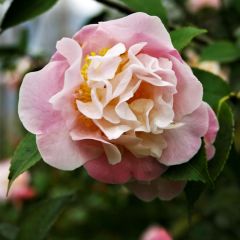
Camellia lutchuensis High Fragrance
- Flowering time March to May
- Height at maturity 1,50 m
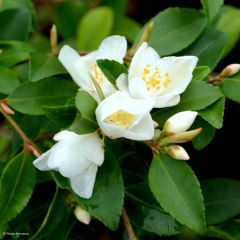
Camellia lutchuensis
- Flowering time April, May
- Height at maturity 1,20 m
Discover other Camellia
View all →Available in 0 sizes
Available in 1 sizes
Available in 1 sizes
Available in 1 sizes

Available in 1 sizes
Available in 1 sizes
Available in 1 sizes
Available in 1 sizes
Available in 1 sizes
Available in 1 sizes
Planting a camellia: where, when and how?
Where to plant camellias?
All camellias prefer soil rich in humus, but light and slightly acidic. They absolutely cannot tolerate lime. But do not, under any circumstances, plant them in pure heather soil. That substrate is far too poor for a camellia to grow under optimal conditions. However, mixed with good garden soil, it becomes particularly welcoming for all plants that appreciate acidic soils.
As they are understorey bushes in their native habitat, camellias are planted in shade or partial shade. Camellia sasanqua can tolerate full sun (especially north of the Loire); it can even be used to create a pretty hedge by the seaside.
Be careful not to plant them too close to a wall, as soil there is then far too dry. Under a tree, take into account soil dryness too; consider covering soil at the base of your camellia with a good layer of leaf mulch. Camellias appreciate some moisture, particularly during their flowering period. They do not tolerate heavy, oxygen-deprived soils that are saturated with water in winter.
When to plant camellias?
Planting should be carried out after frosts, i.e. in April–May depending on your climate for camellias with autumn and winter flowering. If you cannot resist buying one while it is in flower, since that is the best time to choose, you can keep it patiently in your conservatory or in a frost-free shelter until the right planting season. Planting is done in autumn for camellias that flower in spring.
How to plant camellias?
Here are the steps to plant a camellia correctly:
- Moisten the pot by immersing it in a bucket of water for two hours.
- Allow sufficient space for your camellia (remember exposure advice above): at least two metres wide.
- Dig a hole large enough to accommodate the rootball, roughly twice as wide as it.
- Place the rootball at the bottom of the hole, then cover with soil. You can incorporate a little leaf mould at this stage.
- Firm soil at surface and water well with non-calcareous water (6 to 10 L) to avoid leaving any ‘air pockets’ around the roots…. Enjoy your camellia for many years. Consider creating a pleasant little spot nearby to sit and drink tea.
→ Find out more about planting camellias in our tutorial!
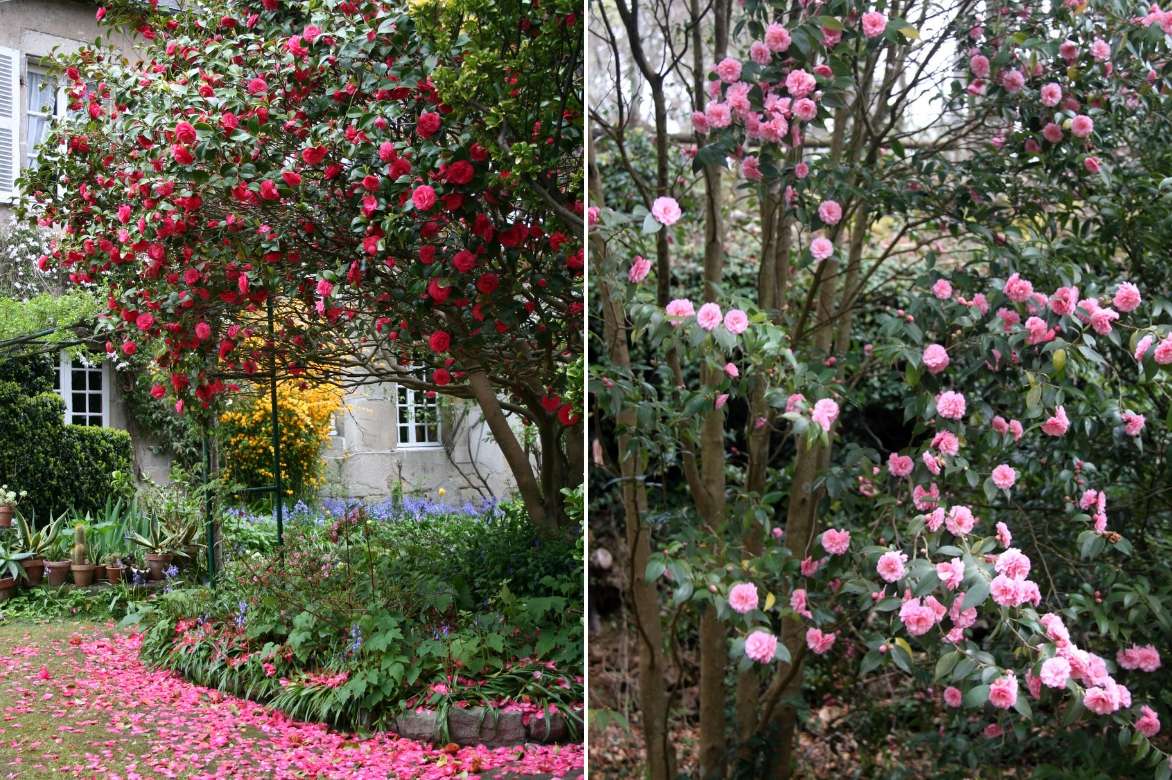
Camelias in situ: Camellia japonica deep pink and Camellia ‘Spring Festival’
→ To read: 7 Camellias to grow in pots
Pruning and care of Camellia
Maintenance is minimal. In autumn, you can add a good mulch of dead leaves at the base of your camellia, to feed it a little and protect it from winter’s rigours. Avoid giving too much fertiliser, camellias do not like that at all.
In winter, also remember to remove snow that covers your camellia and can scorch the leaves and break some branches. If winter looks particularly severe, you can protect your camellia using a winter fleece.
During frosty periods, water is no longer available to the plant, because it is frozen and therefore can no longer be «pumped» by the roots. In this case, remember to water a little as soon as you see a small ray of sun appear, as this will encourage the rise of sap necessary for good flowering.
→ further reading : My camellia in winter: how to care for it? , Camellia: how to protect it from frost and overwinter it?, How to rejuvenate a camellia: techniques and tips, and Sick camellia: what to do?
Also remember to water your camellia in very hot weather, especially the year after planting.
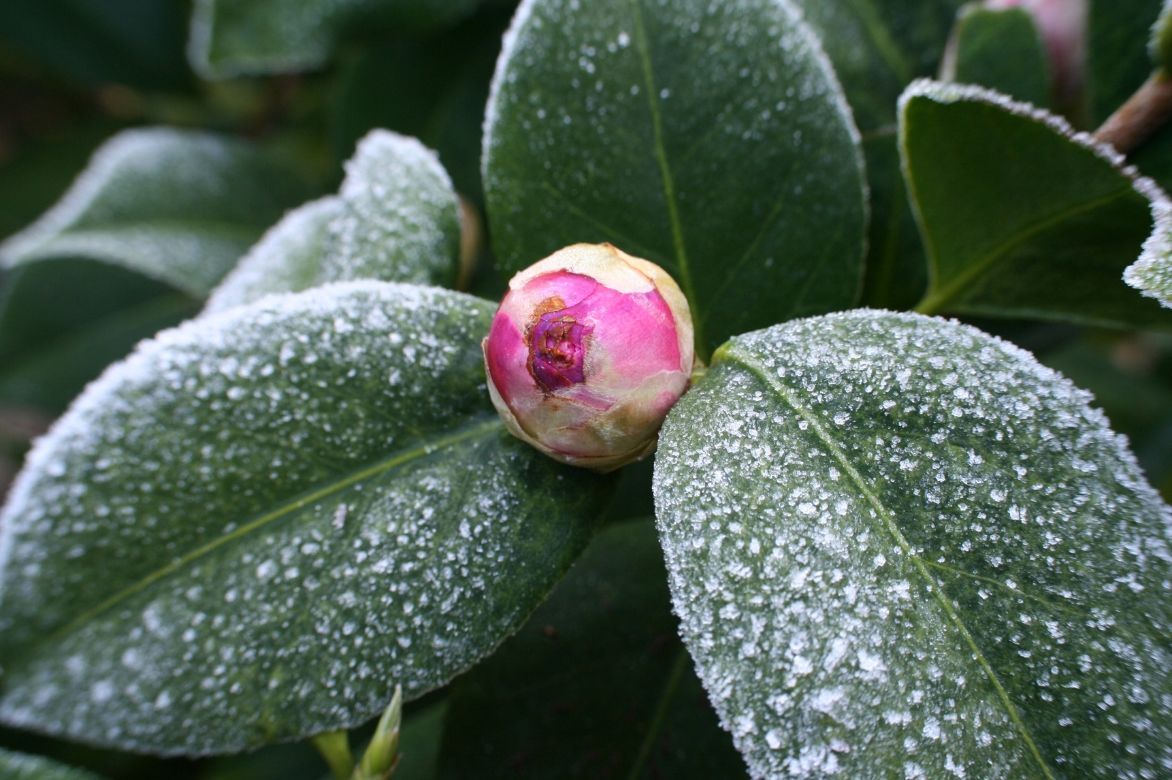
Frosted camellia bud
Also consider removing spent flowers, except on C. x williamsii, to prevent the plant from wasting energy producing seeds rather than flowers.
As for pruning, it’s very simple too. Do not prune! Or almost… Indeed, camellias have no need for pruning to flower and do very well without your intervention. However, a light thinning pruning from time to time can be carried out on C. japonica to aerate the foliage a little. You can also prune C. sasanqua in June if you planted it as a hedge. And, if necessary, you can cut down to ground level a particularly bare, ageing camellia; it will regrow fairly quickly on old wood to become a magnificent bush again. Apart from these particular cases, you can put your pruning shear away. Note, however, that pruning, if carried out, must always follow flowering.
please note : in case of container cultivation, make a mix of 1/3 heather soil, 1/3 potting compost and 1/3 garden soil in a pot with drainage holes and a draining layer at the bottom (gravel, clay pebbles…). Avoid excess water at all costs and provide a container of sufficient size.
Camellia propagation
Forget propagating camellias! Unless you are an expert in grafting and in taking particularly difficult cuttings: these are carried out in a heated greenhouse with misting and plant hormones for cuttings. Layering is still possible for branches closest to ground, but results are far from remarkable…
→ Find out more: How to propagate Camellia?
Companion planting for camellias
- Camellia sasanqua
Since it flowers in autumn, why not pair it with autumn flowers that will flower at its base. Asters, nerines, colchicums, liriopes, cyclamens,… and why not add some evergreen ferns such as these small Asplenium scolopendrium ‘Cristatum group’?
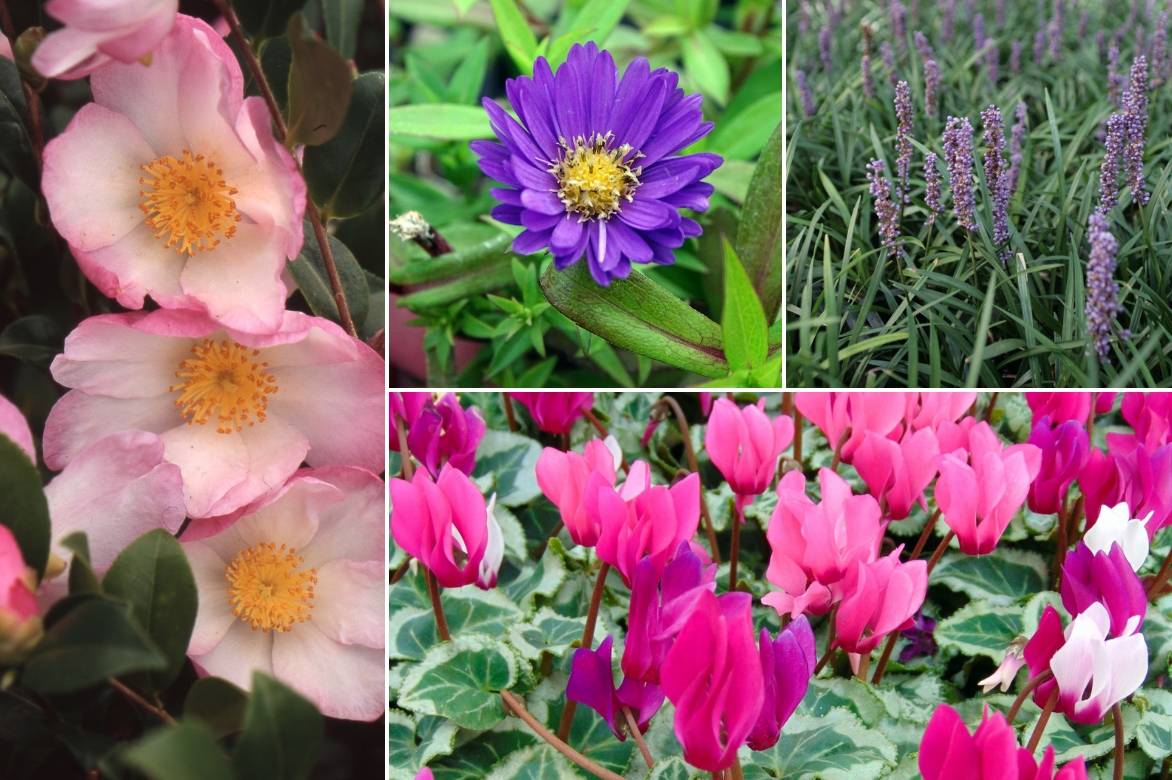
An example pairing: Camellia sasanqua ‘Versicolor’ (©Stervinou), Aster dumosus ‘Samoa’, Liriope muscari ‘Ingwersen’, Cyclamen persicum (photo PAP) and you can also add some bulbs of Nerine flexuosa ‘Rose’ and Colchicum autumnale ‘Major’
- Camellia japonica
Let’s set off immediately on an extraordinary journey into the heart of a Japanese forest by pairing it with a Japanese cherry, a fine Japanese maple in full bud burst period when the camellia is in flower and perhaps one of the earliest rhododendrons of the year. Add some Japanese primroses and other ferns from the Land of the Rising Sun and there you have it. Change of scene guaranteed!
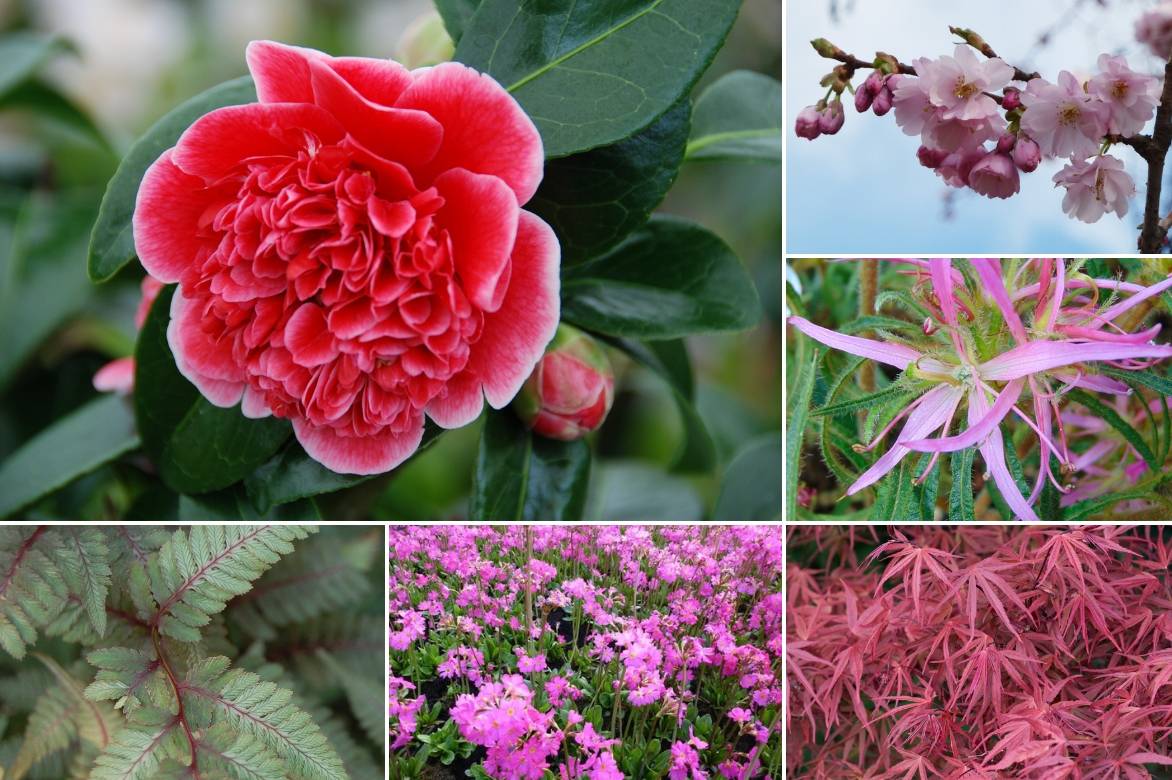
An example pairing: Camellia japonica ‘Volunteer’ (©Stervinou), Prunus ‘Accolade’ (photo Wendy Cutler-Flickr), Rhododendron linearifolium, Acer palmatum ‘Red Pigmy’, Primula rosea ‘Grandiflora’, Athyrium nipponicum ‘pictum Red Beauty’ (only emerging from June…) otherwise replace it with an Asian evergreen Cyrtomium falcatum
- Camellia x williamsii
In a slightly rustic flowering hedge, wouldn’t it be in good company between an ornamental crab apple and that handsome hawthorn? It might even steal the show (you little rascal!) from that lovely Cornus kousa ‘Miss Satomi’.
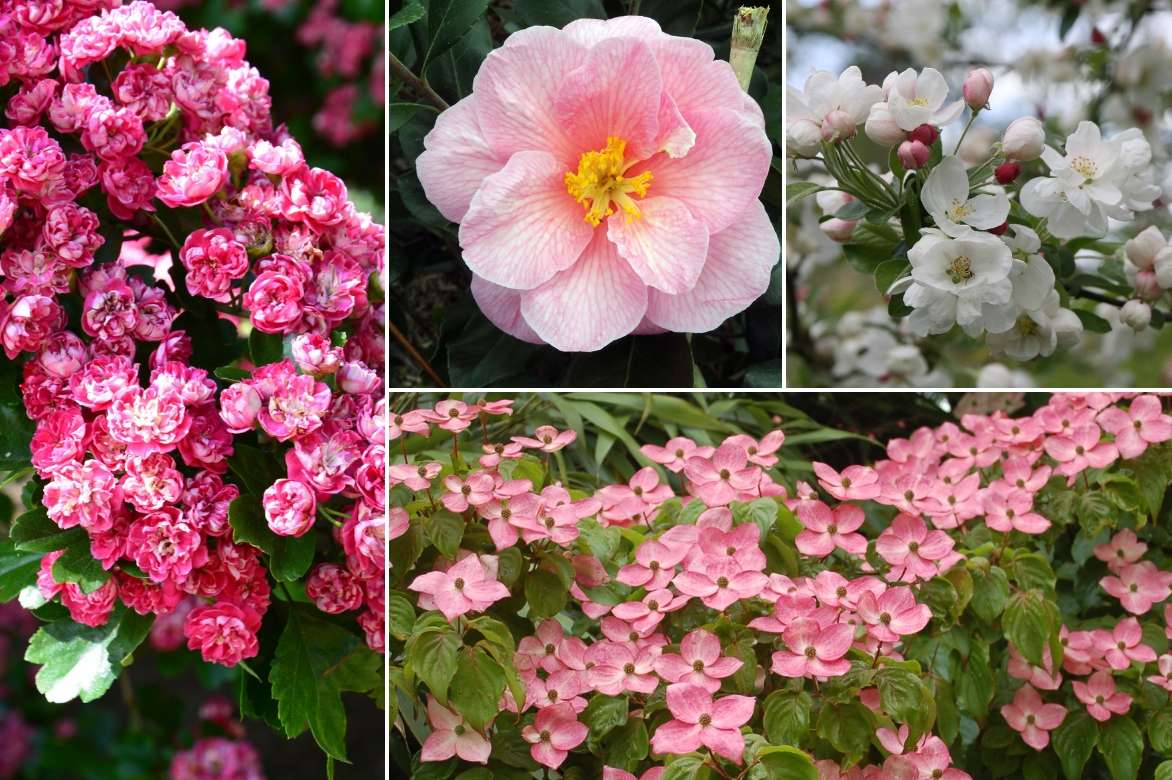
An example pairing: Malus ‘Evereste’, Camellia x willamsii ‘Donation’, Crataegus laevigata ‘Paul Scarlet’, Cornus kousa ‘Satomi’
→ Discover ideas for pairing with autumn camellias
Anecdotes to shine at social gatherings
- Marguerite Gauthier, the main character of ‘The Lady of the Camellias‘ by Alexandre Dumas (the son, not the author of ‘The Three Musketeers‘!), hated scented plants that made her cough, which is why she worshipped the type species of Camellia japonica whose flowers have no fragrance.
- You have probably noticed: the Latin name is spelt ‘Camellia’ with two ‘L’s. Yet the French name is spelt with only one ‘L’. Blame Alexandre Dumas’s son, who wrote ‘Camélia’ with a single ‘L’ in his novel. The spelling then stuck…
- Ornamental camellias were unknown in the West until a crafty fellow in the 18th century sent to England young plants of Camellia japonica instead of Camellia sinensis, intended for tea. Result: the tea was dreadful, but some thought this magnificent plant deserved wider cultivation in gardens. It eventually became a great success in Europe. (And Joséphine de Beauharnais, who started the camellia craze in France, would wholeheartedly approve this paragraph!). Note that ornamental camellias had long been adored in Asia for hundreds of years.
- Another camellia is used in the food industry for its oil: Camellia oleifera.
Further reading
Discover our wide range of Camellias
Our guide: How to choose an autumn Camellia
Our guide: How to pair autumn Camellias?
Our guides on pink autumn Camellias, autumn Camellias with white flowers, 7 classic white Camellias, 7 classic Camellias with pink flowers, 6 Camellias with red flowers, 6 Camellias with bicoloured flowers
Our guide: 7 Camellias to grow in pots
Discover our tutorials :
- How to prune Camellias?
- How to make homemade tea?
- How to grow a tea plant in a pot?
Frequently asked questions
-
Why are flower buds on my Camellia dropping?
Camellias like cool, moist soil and need moisture to bloom well. Remember to water while flower buds are forming.
-
My soil is not acidic; can I still try growing a camellia?
Camellias prefer acidic, humus-rich soil. Two options are available: plant in a pot in a mix of 1/3 garden soil, 1/3 potting compost and 1/3 heather soil or, in open ground, dig a large hole and replace the soil with the same mix used for potting. Over the years, keep an eye on your camellia and add heather soil if it begins to show signs of chlorosis (see above). For information, this planting technique for acid-loving young plants was adopted at Vasterival in Normandy on calcareous soil.
-
How can I protect my camellia over winter?
Camellias tolerate frosts down to −10 °C. You can nevertheless protect them by keeping a layer of mulch on the soil to protect the roots and, incidentally, retain moisture. You can also protect them with horticultural fleece or, if potted, move the pot to a frost‑free spot. Do not water your camellia during frost, but as soon as the temperature rises above freezing, give it some water to aid its flowering.
-
My Camellia's leaves are turning yellow — what should I do?
Camellias prefer acidic soils and cannot tolerate lime, because lime blocks iron assimilation, causing an iron deficiency and leading to chlorosis. To remedy this, apply an acidifying mulch such as pine needles or use an anti-chlorosis product. If still young, lift your camellia, replace soil with a mix of one-third heather soil, one-third potting compost and one-third garden soil, then replant your bush.
- Subscribe!
- Contents
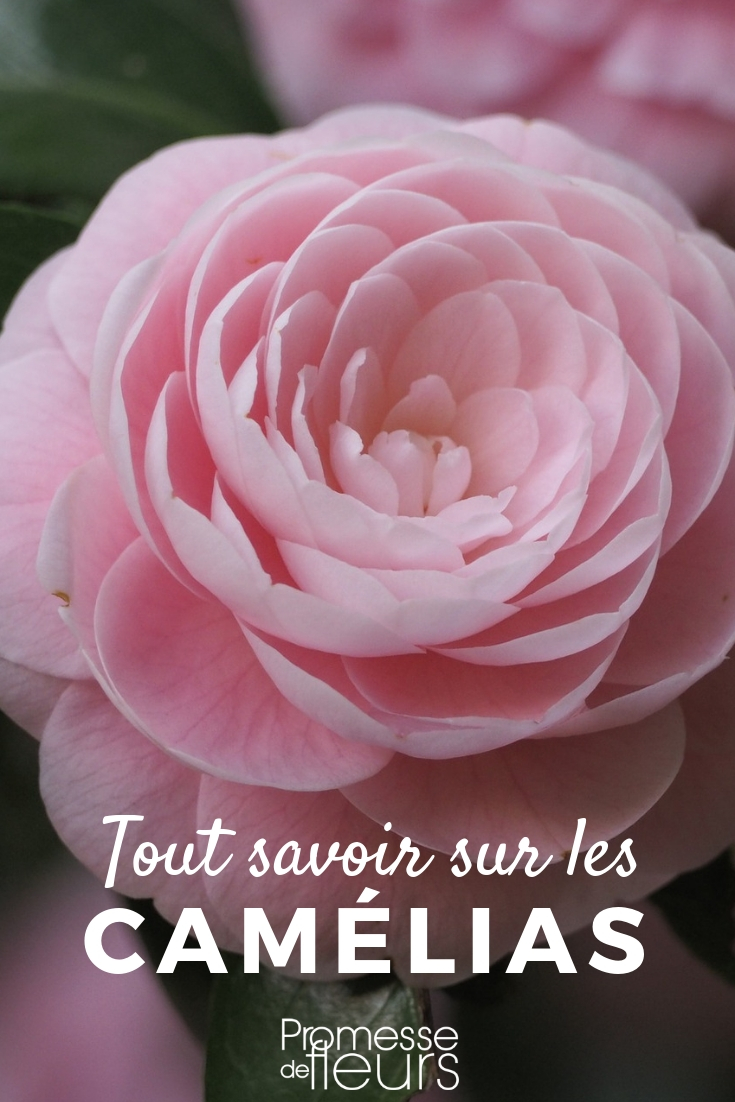






























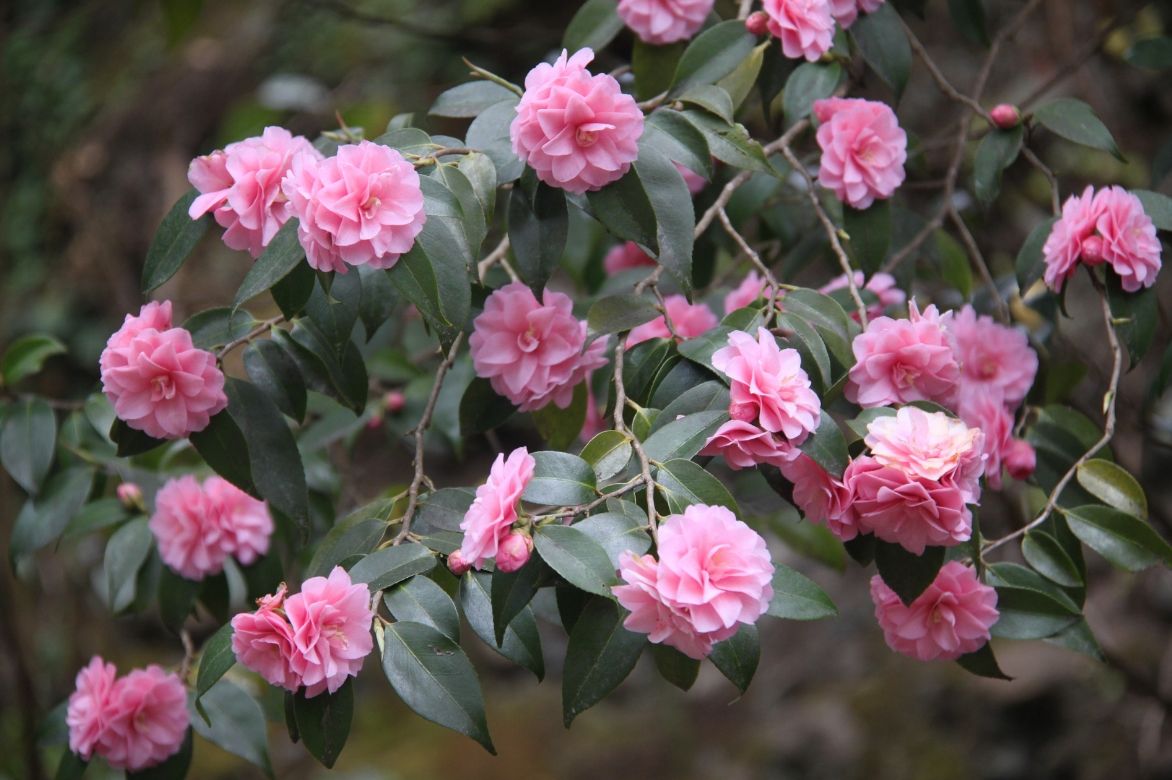

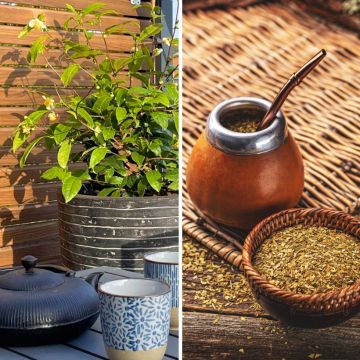
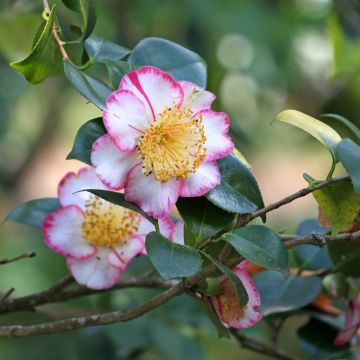


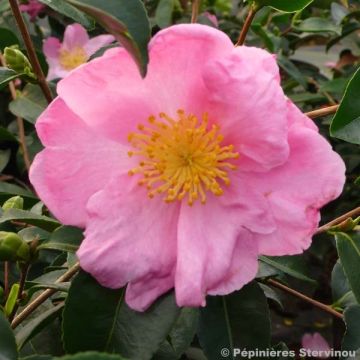
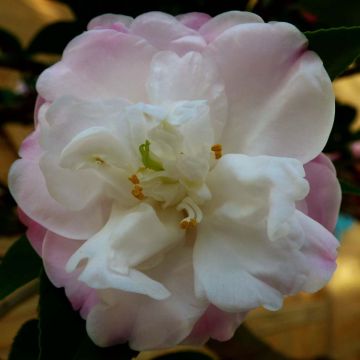
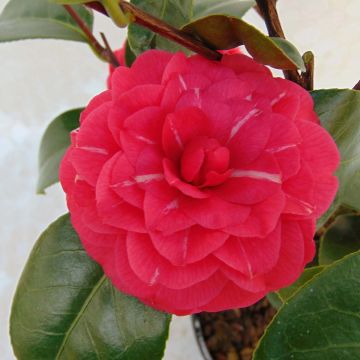
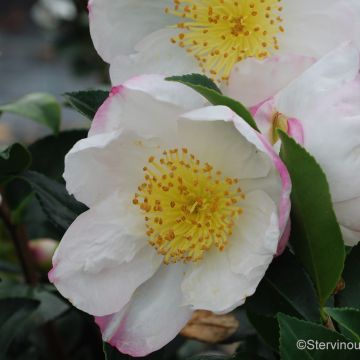
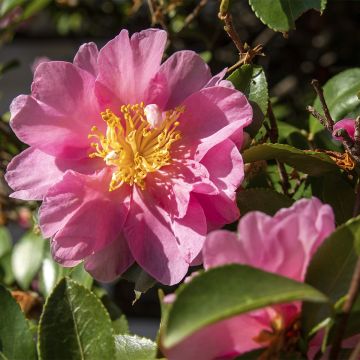
Comments